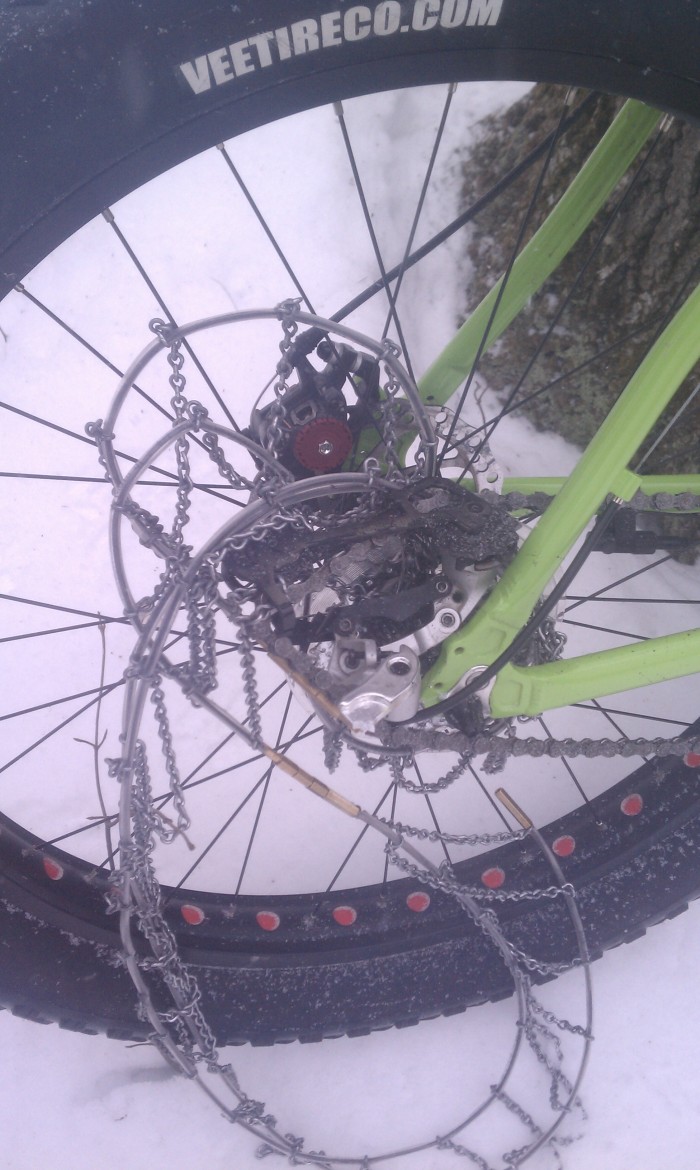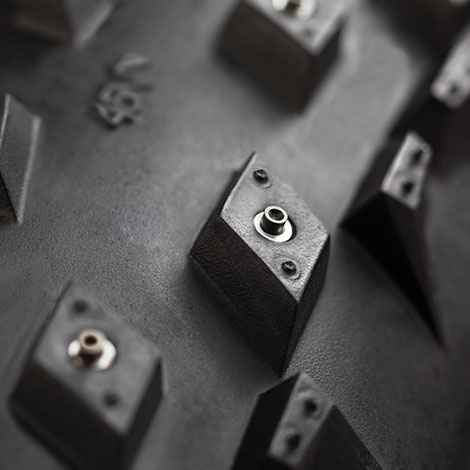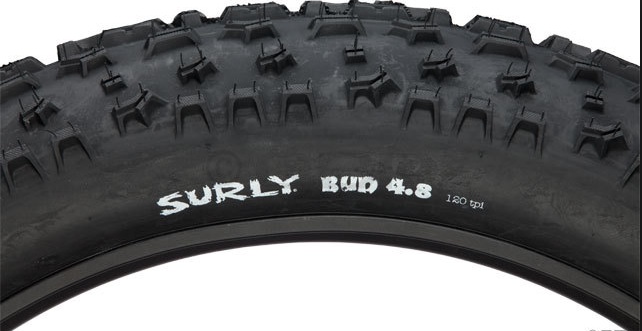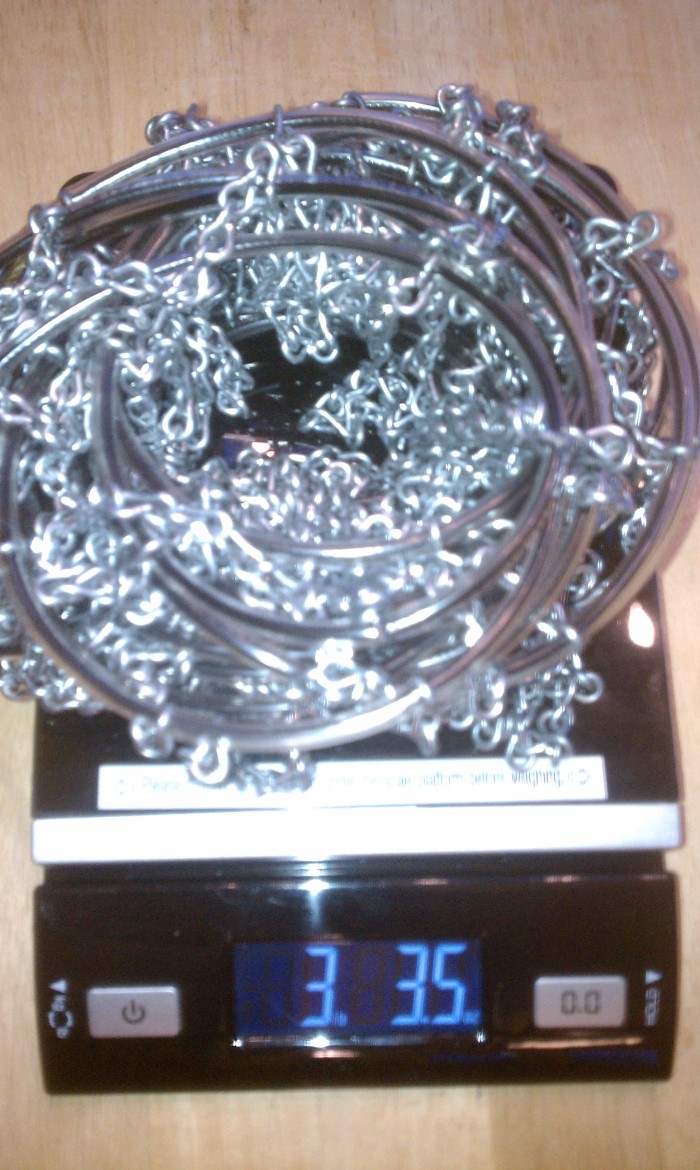Several weeks ago I was hitting a banked turn on a snowmobile track going over 25mph with chains on when the bike slipped out from under me and I hit the ice so fast I didn’t know what hit me. After that incident I borrowed a set of Dillinger 4 studded fatbike snow tires from my good friend Larry at Boxy Bikes to try them out. Larry had the cheaper 27tpi casing with the wire bead which weighed in at a hefty 3.78lbs each with 240 mounted studs. The Dillinger 4 streetprice is around $135.
The chains I’ve been using were purchased from Justin at slipnottraction.com for $105 + shipping.
For ‘big ass lugs’ (7mm) the tires that I keep going back to are the Surly Lou and Bud which were purchased online for about $130 each shipping included.
I’ve been riding electric fatbikes about 1.5 hrs almost every single day this winter and in a wide variety of conditions. The average amount of snow I’ve ridden in is about 3-4″ and generally I try to stick to packed down singletrack trails as much as I can, although sometimes when it gets warmer and slushy I have to stay on the snowmobile trails. I’ve found that each of the three tires excel in different conditions. I’ve listed each tire in the order that I would consider it to be based on different conditions with a number from 1-10 rating how good that tire is in those conditions.
Glare Ice
- 8 – Dillinger – This is where the 240 studs excel. On glare ice they stick better than any fat tire I’ve used, and I feel safe and confident going over 20mph in these conditions. For a winter commuter I would consider no other option. That being said a much skinnier tire with 240 studs should grip much better than this giant tire running at really low pressure.
- 3 – Slipnot Chains – If the ice is flat and you don’t try to turn or stop they might work fine, but for the most part they just suck on ice.
- 1 – Bud\Lou – Forget it, you’ll be on your ass faster than you know what hit you.
Deep Powder (3-4″ or more)
- 9 – Bud\Lou – Nothing else I’ve tried even comes close. The Bud really shines as it is the only option that doesn’t wash out in the turns when there is a lot of powder. I keep going back to these tires on any bike they will fit on.
- 7 – Slipnot Chains – They grip, but not as well as you think they should. The front tires still seem to wash out in the turns even when you think it shouldn’t. Good for traction but when they accidentally come off then have a nasty tendency to grab the derailleur and make a big mess.
- 5 – Dillinger – The treads just aren’t deep enough. Decent traction for a rear tire, but as a front tire it just doesn’t provide enough lateral traction.
Wet Slushy Snow
- 7 – Bud\Lou – These are the worst conditions to ride in. You need as much width as you can get and as much bite as you can get.
- 5 – Slipnot Chains – Better on the rear than on the front. When riding in these conditions I always wish I had a larger tire with lower pressure rather than chains.
- 4 – Dillinger – Just not enough bite. I tried mounted the tires backwards to get more traction but then they slid around even worse.
Hard Pack Snow with rough ice patches
- 7 – Dillinger – As long as there is not a lot of cover (less than an inch) the studded tires seem to do particularly well. I never slow down when there is ice patches, great tires for these conditions
- 6 on the ice patches 7 on the snow – Slipnot chains – I get a little scared on the rough ice patches but chains are pretty awesome on the hard packed snow. I go 25mph with total confidence in these conditions.
- 6 – Bud\Lou – A lot of rolling resistance and you don’t seem to need all that traction in these conditions. Seem to grip about the same on rough ice as the chains.
You should always use the biggest tire you can fit on your frame. Many bikes sold with 4″ tires can fit much larger tires. Also the tire width changes dramatically based on the rim width. The Boris frame will fit a Bud on the front, but nothing bigger than a 4″ tire on the rear. Chains won’t even fit on a stock Boris with Mission Vee 4.0 tires on it because of lack of clearance with the chainstay. The Bullseye Monster will fit a Bud on the front and chains on the rear, but it won’t fit a Lou on the rear. The Deadeye Monster will fit a Bud on the rear but not on the front, although there is enough clearance for a 4″ tire with chains.
Here is an example of some sample bike tire widths
- Lou 4.8″ tire on a 50mm rim – 3.83 inches
- Mission Vee 4.0 on a 50mm rim – 3.27 inches
- Bud 4.8″ tire on a 80mm rim – 4.07 inches
- Dillinger 4 studded tire on 80mm rim – 3.73 inches
With chains you will need a little more than 1/4″ clearance all the way around the tire. Chains are also the heaviest option adding about 1.5 lbs per tire. People often wonder if you really need chains on the front, to which I say if you can only mount one chain, the front is the place to have it. Having the front wash out in turns is no fun and having the rear tire fish-tail under power is actually pretty fun. Losing traction in the rear is generally recoverable by putting a foot down, losing traction in the front generally isn’t.

Even with checking the adjustments before and after every ride I still get this mess from time to time. Can you find the derailleur in that picture? Guess I need to locktite the turnbuckles.
For commuting the studded tires seem to be the only way to go. Who wants to wipe out on glare ice and end up under the wheels of a truck? If you good want snow traction that you can take off and put on at will, then chains are the best bet (but locktite the turnbuckles esp on the rear). If you want raw performance in the powder Bud\Lou is the only way to go. For the most part get the widest tires with the biggest lugs you can squeeze into your frame and run them at 5-6 psi for maximum enjoyment in the woods.
Our first review of the Slipnot chains is here.
The Surly Lou rear tire is reviewed by us here.
The Surly Bud front tire review is here.
Ride On




No comments:
Post a Comment